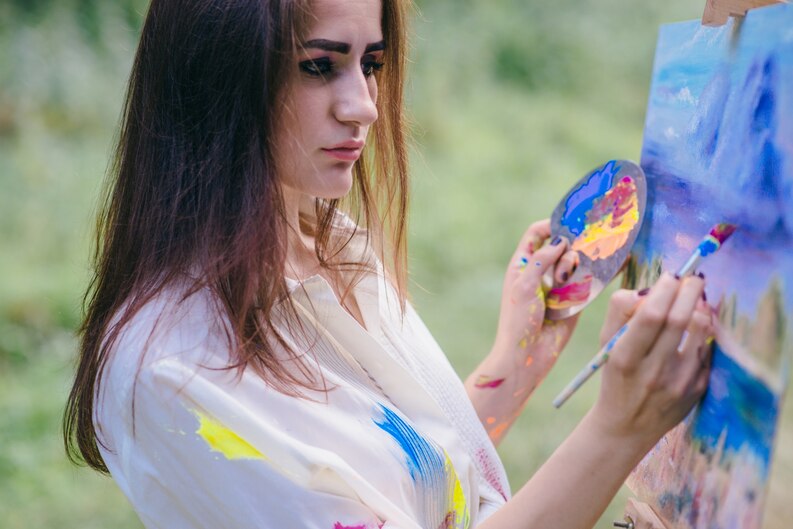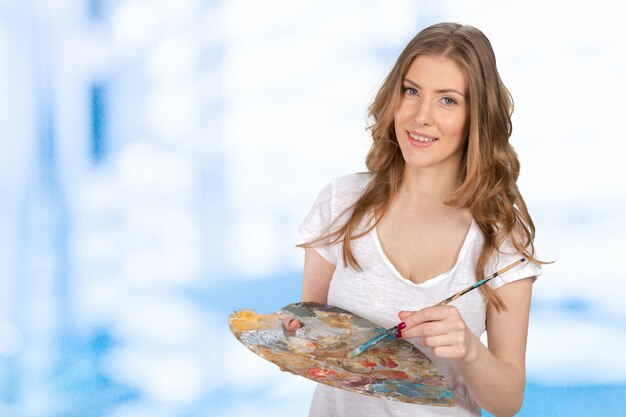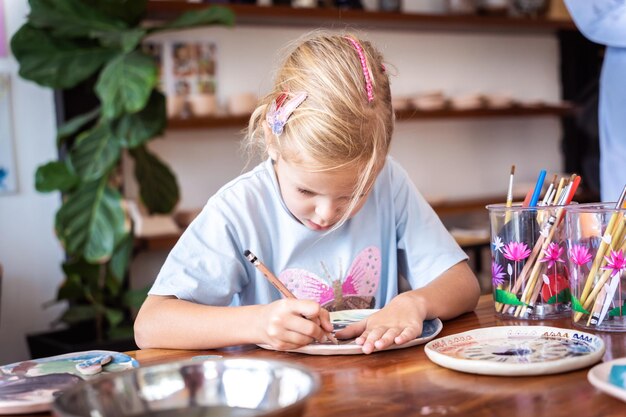Acrylic Paintings from Top Artists
Stare in Wonder at More Than Two Dozen Inspiring Acrylic Paintings
If you want to talk about a modern-day art medium success story, look no farther than the nearest brush loaded with acrylic paint. It was the medium chosen by famous 20th-century artists like Andy Warhol and Mark Rothko. It has put thousands (and counting!) of contemporary artists on the path to excellence.
AcrylicWorks 6: Creative Energy, a book worthy of pride of place, showcases that excellence by featuring the winning acrylic paintings from the latest AcrylicWorks art contest. It is hot off the presses and available now!
Enjoy 25 acrylic paintings from 25 top artist-entrants whose works span subject matter and style, but all consistently deliver “best-in-show” power.
#1 Letting Go by Randy L. Honerlah
One sees what comes to mind . . . an abstraction of trees reaching for the heavens and releasing their leaves, or a courageous awakening to look up, breathe deep and expand on your awareness. We can learn from the nature of trees, staying grounded regardless of life’s obstacles.
The value play of light and dark colors helps to represent these concepts. The breakdown of shapes, adjacent colors and values in this work reveals these ideas and keeps it fresh and uplifting.
#2 Lanterns by April M. Rimpo
What seems at first glance to be black is really layers of purple, Phthalo Blue and other dark pigments to gradually build the darkest areas. The lighter grays were also mixed using Cobalt Blue, Quinacridone Coral and Quinacridone Gold.
Rimpo creates her own grays and blacks by mixing colors. The result is much richer than using tube blacks or grays.
#3 Fancy Feathers by Cher Anderson
Fancy Feathers was the result of hours of waiting to capture the perfect moment when the flamingo opened his wing and displayed the spectrum of values from light, soft pink to deep black and every color in between. His head arched and his dark beak preening created a dramatic effect and displayed a beauty seldom seen.
Painting with acrylics allows the freedom of layering very thin washes of color and slowly building the shape and form for a smooth transition from light to dark. It also gives opacity and intensity to color, needed to bring the subject to life realistically.
#4 Bill by Michael Wagner
There is a lot of color and texture in the skin tones of most portraits. Wagner finds when he applies it loosely it appears more realistic and lush.
He painted Bill with a full range of color values, and used texture and color to achieve a photorealistic appeal. The detail apparent in the wrinkles, folds and features interested the artist.
#5 Artificial Nature by Jingyi Wang
To Wang, cacti represent all creatures in nature. Through the strong and independent characteristics that the cacti represent, the artist hopes to express the impact that human activity has on nature. The cast shadow in the background is actually a separate picture and represents that the cactus is growing in an unrealistic, unnatural surrounding.
#6 Mellow Yellow #1 by Scott Ramsay
High-key value is very important in setting the mood of this piece. Before the painting was even envisioned, Ramsay made a decision to use dominant, bright yellow values.
The artist wanted to use warm inviting yellows to pull the viewer in. Conversely, he used neutral to cool values in the shadows to punctuate the details.
#7 Butterfly Effect by Yelena York
Butterfly Effect is created freehand from the artist’s own imagination. Every pattern has been developed during the process. Nothing was sketched before starting the piece.
The work is done with acrylic paints, sometimes mixed with different mediums to create vibrant and translucent effects on the wings.
#8 Utility Pole by Jim Martinez
Martinez wanted to incorporate a little humor and give the subject an electric feel. The use of bold values was critical in that it brings attention to an object that was not designed to be aesthetically pleasing. However, when it’s looked at through another lens, it becomes pretty interesting.
#9 Crystal Blue Persuasion by Deborah B. Leonard
A partially frozen brook was Leonard’s inspiration for this work. The varying levels of ice crystals, snow and dark-moving water all had to be captured.
She used several different brushes as she constructed the combination of swift-moving and partially static areas. The varying shades of blue — from deep to almost pure white — convey the coldness. The warmer tones give a nod to the decaying leaves and pine needles that were on the shallow banks.
#10 Wood 1 by Ellen Fuller
This painting is part of a series Fuller is currently working on. It was based on photographs she took of wooden barricades in Canyonlands National Park in Utah.
The artist decided to use only black and white acrylic paint because she felt color might weaken the dramatic effect of the wood’s nuanced surfaces. By taking away color, she was able to concentrate on the minute details, composition and brushstrokes, which gave her a complete understanding of the bark’s fascinating textures.
#11 Oaxaca Series #5 by Robert Merrill Sweeny
Sweeny’s Oaxaca series is the product of a group of photographs that were taken while the artist was on vacation in Oaxaca, Mexico. He has always felt an affinity for the print arts, which are very popular in Oaxaca to the point that they spill out into the streets in the form of graffiti.
In this piece, Sweeny was drawn to the rich blacks of the poster in combination with the wonderful deep shadows cast by the curled paper and peeling paint.
#12 Frances (Portrait Series #5) by Katia Zhukova
The artist works with heavy body acrylics. The fast drying nature of acrylics is perfect for her technique, which uses many quick textured layers applied with palette knives and brushes.
#13 Unknown by Marney-Rose Edge
Texture is in the foundation of the work. Edge used molding paste in the nest area and Clear Tar Gel drizzled over the canvas before paint was applied. Gold and silver foil is scattered throughout the background amid the layers of paint.
The artist used heavy body acrylics for coverage, then progressed to fluid acrylics for the ethereal feel in the background and acrylic inks for glazing the eggs.
#14 The Morning After the Snowstorm by Ray Hassard
The artist applied a bright orange underpainting — the complement of the blue — as a unifying element. You can see a lot of it on the garage wall, but it peeks through all over. Hassard used mostly heavy body acrylics without extenders or other mediums.





